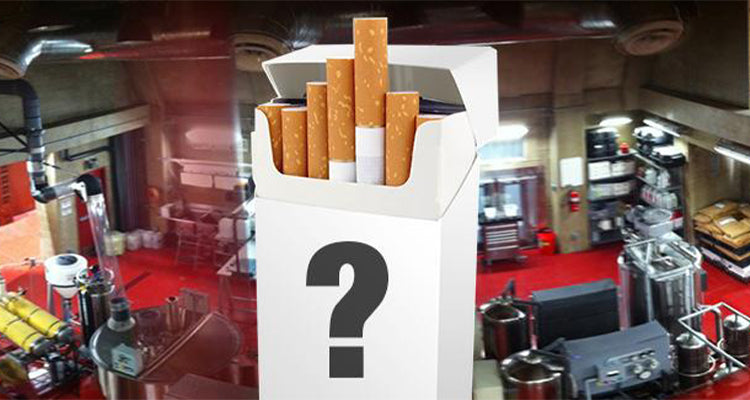Type “electronic cigarettes” into any search engine and you will find heaps of information about the Electronic Nicotine Delivery devices (ENDs). Most, if not all, e-cigarette companies promote the same list of 4 base e-liquid ingredients in their products: propylene glycol, vegetable glycerin, flavoring (both natural and artificial) and nicotine. All of these ingredients are listed in the US Pharmacopeia. Prior to 1994, Big Tobacco had kept the list of ingredients in cigarette tobacco a secret for years. This begs the question, exactly what chemicals are on this list of ingredients in tobacco cigarettes?
The Harmful Chemicals in Tobacco Cigarettes
In 1994, the list of 599 additives in cigarettes was submitted to the United States Department of Health and Human Services. The 5 major tobacco companies that contributed to the report were: Brown and Williamson, Liggett Group, Inc., American Tobacco Company, R.J. Reynolds, and Phillip Morris.
It should be noted that although the FDA has listed many of these chemicals as safe for consumption and acceptable ingredients in food, their usage in cigarettes becomes a different matter. When a cigarette is burned, the tobacco leaves within are heated beyond the point of combustion and undergo a physical and chemical change through pyrolysis. This is the point at which existing molecular bonds are broken and new ones are formed.
Unfortunately for the smoker, many of these new chemical constituents are poisonous and can cause severe damage to human tissue. Below is a brief list of some of the more recognizable and dangerous additives in cigarette tobacco. The complete list submitted in 1994 can be found here.
Benzene

Benzene is used in the manufacturing of other chemicals such as nylon, pesticides and gasoline. It is present in cigarette smoke and, while definitive conclusions have not yet been drawn, it is generally understood that smokers face an increased risk of leukemia over their nonsmoking peers. Short-term, high level exposure to benzene through inhalation or ingestion can cause damage to the central nervous system leading to paralysis. Long-term exposure to benzene can lead to anemia, hemophilia and leukemia.
Cyanide

Cyanide is present in the chemicals used to make numerous products such as paper, textiles and plastics. As a gas, cyanide is used in pesticides. Under the name of Zyklon B, hydrogen cyanide was used in concentration camps as a genocidal agent during World War II. Hydrogen cyanide is present when cigarette smoke is inhaled and in the smoke from the burning end of a lit cigarette. Nonsmokers are also at risk when exposed to cigarette smoke.
Carbon Monoxide

Carbon Monoxide (also known as The Silent Killer) is a poisonous, colorless and odorless gas. Cigarette smoke contains high levels of carbon monoxide (molecular symbol CO). When inhaled, CO binds with hemoglobin in the lungs, decreasing the amount of red blood cells necessary to transport oxygen throughout the body.
2,3-Butanedione

Commonly known as diacetyl, 2,3-Butanedione is a chemical naturally found in foods like coffee, honey and some fruits, and is commonly used in food production to achieve a buttery or sweet taste. 2,3-Butanedione has been linked to a rare but severe lung disease called bronchiolitis obliterans, which is also known as “popcorn lung”, a term adapted when popcorn factory workers acquired the disease after being exposed to high levels of the vaporized substance. Early signs of the condition include fever, malaise and chronic coughing, and if left untreated, popcorn lung can ultimately cause irreparable damage to the point that patients require a lung transplant.
The Evolution of Additives in Cigarette Tobacco
Tobacco companies have dedicated a significant amount of resources to the research and development of their product. The formula for cigarette tobacco is always evolving. Prior to 1970, cigarettes manufactured for use in the United States used few additives, and there is evidence that the percentage of additives increased in the 1990s.
More than 100 of the additives in tobacco cigarettes are used to make the product more desirable for the consumer. According to tobacco companies, these compounds are added to improve taste and reduce harshness. In all likelihood they do, but they also camouflage their odor, enhance the nicotine delivery, mask symptoms of illness and increase the addictiveness of cigarettes.
In electronic cigarettes, once the level of nicotine reaches a certain point, the throat hit becomes too harsh and they no longer feel smooth. Smokers will absorb about 1 mg of nicotine per cigarette (10 puffs) where e-cigarette users will absorb 0.1 mg vaping the same amount.
Related: The Differences Between Tobacco Cigarettes and E-Cigs
It wasn’t until April of 1994 that Big Tobacco released a partial list of what additives are in their tobacco products. All of these companies were founded and began the production of cigarettes in the 1800s. Brown and Williamson, the “newest” of these corporations began production in 1894. What would possess these publicly traded companies to keep the list a secret for over a century? One can ask, but it may take Big Tobacco a decade or two to answer.
For more information about tobacco, see Tobacco FAQ’s.






